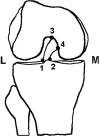Posterior cruciate ligament recruitment affects antero-posterior translation during flexion gap distraction in total knee replacement. An intraoperative study involving 50 patients
- PMID: 20809745
- PMCID: PMC2917571
- DOI: 10.3109/17453674.2010.501743
Posterior cruciate ligament recruitment affects antero-posterior translation during flexion gap distraction in total knee replacement. An intraoperative study involving 50 patients
Abstract
Background and purpose: Because of the oblique orientation of the posterior cruciate ligament (PCL), flexion gap distraction could lead to anterior movement of the tibia, which would influence the tibiofemoral contact point. This would affect the kinematics of the TKR. We assessed the flexion gap parameters when the knee is distracted during implantation of a PCL-retaining TKR. Furthermore, the effects of PCL elevation (steep or flat) and collateral ligament releases on the flexion gap parameters were determined.
Methods: During a ligament-guided TKR procedure in 50 knees, the flexion gap was distracted with a double-spring tensor with 200N after the tibia had been cut. The flexion gap height, anterior tibial translation, and femoral rotation were measured intraoperatively using a CT-free navigation system.
Results: During flexion gap distraction, the greatest displacement was seen in anterior-posterior direction. Mean ratio between increase in gap height and tibial translation was 1 to 1.9, and was highest for knees with a steep PCL (1 to 2.3). Knees with a flat PCL and knees with a ligament release had a larger increase in PCL elevation when the gap was distracted.
Interpretation: When the PCL is tensioned, every extra mm that the flexion gap is distracted can be expected to move the tibia anteriorly by at least 1.7 mm (flat PCL), or more if there is a steep PCL. This changes the tibiofemoral contact point, which may have consequences for polyethylene wear.
Figures






Similar articles
-
Posterior cruciate ligament balancing in total knee replacement: the quantitative relationship between tightness of the flexion gap and tibial translation.J Bone Joint Surg Br. 2007 Aug;89(8):1046-50. doi: 10.1302/0301-620X.89B8.18976. J Bone Joint Surg Br. 2007. PMID: 17785743
-
Comparative evaluation of posterior cruciate ligament in total knee arthroplasty.J Orthop Surg (Hong Kong). 2017 Jan;25(1):2309499017690976. doi: 10.1177/2309499017690976. J Orthop Surg (Hong Kong). 2017. PMID: 28219307
-
Joint distraction force changes the three-dimensional articulation of the femur and tibia in total knee arthroplasty: a cadaveric study.Knee Surg Sports Traumatol Arthrosc. 2020 May;28(5):1488-1496. doi: 10.1007/s00167-019-05546-8. Epub 2019 Jun 4. Knee Surg Sports Traumatol Arthrosc. 2020. PMID: 31165182
-
Posterior cruciate ligament resection under minimum medial collateral ligament release changes tibial internal rotation, joint center gap, and varus ligament balance on joint distraction force at flexion in total knee arthroplasty.Clin Biomech (Bristol). 2023 Feb;102:105897. doi: 10.1016/j.clinbiomech.2023.105897. Epub 2023 Jan 27. Clin Biomech (Bristol). 2023. PMID: 36773502
-
Influence of component design on in vivo tibiofemoral contact patterns during kneeling after total knee arthroplasty: a systematic review and meta-analysis.Knee Surg Sports Traumatol Arthrosc. 2021 Feb;29(2):446-466. doi: 10.1007/s00167-020-05949-y. Epub 2020 Apr 3. Knee Surg Sports Traumatol Arthrosc. 2021. PMID: 32242268
Cited by
-
Is There a Force Target That Predicts Early Patient-reported Outcomes After Kinematically Aligned TKA?Clin Orthop Relat Res. 2019 May;477(5):1200-1207. doi: 10.1097/CORR.0000000000000600. Clin Orthop Relat Res. 2019. PMID: 30531423 Free PMC article.
-
Posterior cruciate ligament balancing in total knee arthroplasty: a numerical study with a dynamic force controlled knee model.Biomed Eng Online. 2014 Jul 2;13:91. doi: 10.1186/1475-925X-13-91. Biomed Eng Online. 2014. PMID: 24990257 Free PMC article.
-
No difference in anterior tibial translation with and without posterior cruciate ligament in less invasive total knee replacement.Knee Surg Sports Traumatol Arthrosc. 2012 Mar;20(3):503-9. doi: 10.1007/s00167-011-1560-7. Epub 2011 Jun 1. Knee Surg Sports Traumatol Arthrosc. 2012. PMID: 21630048 Free PMC article.
-
Criteria for preserving posterior cruciate ligament depending on intra-operative gap measurement in total knee replacement.Bone Joint Res. 2014 Apr 9;3(4):95-100. doi: 10.1302/2046-3758.34.2000228. Print 2014. Bone Joint Res. 2014. PMID: 24719296 Free PMC article.
-
On the consequences of intra-operative release versus over-tensioning of the posterior cruciate ligament in total knee arthroplasty.J R Soc Interface. 2024 Dec;21(221):20240588. doi: 10.1098/rsif.2024.0588. Epub 2024 Dec 18. J R Soc Interface. 2024. PMID: 39689844 Free PMC article.
References
-
- Amis AA, Bull AM, Gupte CM, Hijazi I, Race A, Robinson JR. Biomechanics of the PCL and related structures: posterolateral. posteromedial and meniscofemoral ligaments. Knee Surg Sports Traumatol Arthrosc. 2003;11:271–81. - PubMed
-
- Banks S, Bellemans J, Nozaki H, Whiteside LA, Harman M, Hodge WA. Knee motions during maximum flexion in fixed and mobile-bearing arthroplasties. Clin Orthop. 2003;((410)):131–8. - PubMed
-
- Bellemans J, Banks S, Victor J, Vandenneucker H, Moemans A. Fluoroscopic analysis of the kinematics of deep flexion in total knee arthroplasty. Influence of posterior condylar offset. J Bone Joint Surg (Br) 2002;84:50–3. - PubMed
-
- Christen B, Heesterbeek P, Wymenga A, Wehrli U. Posterior cruciate ligament balancing in total knee replacement: the quantitative relationship between tightness of the flexion gap and tibial translation. J Bone Joint Surg (Br) 2007;89:1046–50. - PubMed
-
- Covey DC, Sapega AA. Anatomy and function of the posterior cruciate ligament. Clin Sports Med. 1994;13:509–18. - PubMed
Publication types
MeSH terms
LinkOut - more resources
Full Text Sources
Medical
Miscellaneous
